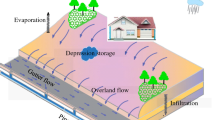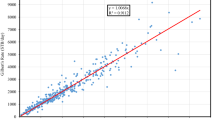Abstract
The benefit of using a weir is that it allows flowrates to be measured and controlled in open channels and streams. The objectives of this research are: (1) to specify a suitable crest depth position as a control section for estimating the flowrate above a curved crump weir at ten different longitudinal slopes and (2) to compare the proposed flowrate versus measured and computational fluid dynamics (CFD)-simulated flowrates. In this research, the crest point of the curved crump weir was considered to be a control section, relating to the critical depth as a function of the crest depth. Experiments with eight different laboratory flowrates of flume were proposed at ten different channel slopes ranging from 0.0 to 2.5%. Statistical analysis of linear regression indicated that the relationship between critical depth and crest depth is 0.913 on average. Based on this finding, a new equation was derived to predict the discharge over the crump weir, which indicated an excellent match compared to the practical and CFD-simulated results (a maximum differences of 4% based on several standard error indexes and a one-way ANOVA). The CFD technique was performed to simulate the velocity and flow pattern of the curve crump weir based on the volume of fraction method. Six selective sections were tested along the flume with a total length of 1.36 m for a case study of 0.912 m3/h flowrate and zero bed slope to investigate and describe the water surface profile. The statistical analysis indicated insignificant differences between the measured and simulated water surface profiles, with a maximum difference of less than 15% observed at the section located at 0.69 m, while the average difference was 4.86% for all sections.









Similar content being viewed by others
References
Giri S, Shimizu Y, Surajata B (2004) Laboratory measurement and numerical simulation of flow and turbulence in a meandering-like flume with spurs. Flow Meas Instrum 15(5–6):301–309. https://doi.org/10.1016/j.flowmeasinst.2004.05.002
Goodarzi E, Farhoudi J, Shokri N (2012) Flow characteristics of rectangular broad-crested weirs with sloped upstream face. J Hydrol Hydromech 60(2):87–100
Abhari MN, Ghodsian M, Vaghefi M, Panahpur N (2010) Experimental and numerical simulation of flow in a 90° bend. Flow Meas Instrum 21(3):292–298. https://doi.org/10.1016/j.flowmeasinst.2010.03.002
Hasan ZA, Lee KH, Azamathulla HM, Ghani AA (2011) Flow simulation for lake Harapan using CCHE2D—a case study. Int J Model Simul 31(1):85–89. https://doi.org/10.2316/journal.205.2011.1.205-5460
Azimi AH, Rajaratnam N, Zhu DZ (2012) Discharge characteristics of weirs of finite crest length with upstream and downstream ramps. J Irrig Drain Eng 139(1):75–83. https://doi.org/10.1061/(ASCE)IR.1943-4774.0000519
Jalil SA, Ibrahim SS, Jafer RA (2014) Surface roughness effects on discharge coefficient of broad crested weir. Res J Appl Sci Eng Technol 7(24):5227–5233. https://doi.org/10.19026/rjaset.7.918
Haider S, Gabriel HF, Khan SA (2017) Supercritical flow simulation at a right channel junction. Comparison between a uniform and a sparse mesh. KSCE J Civ Eng 21(7):2984–2990. https://doi.org/10.1007/s12205-017-0811-7
Al-Husseini TR, Al-Madhhachi AT, Naser ZA (2020) Laboratory experiments and numerical model of local scour around submerged sharp crested weir. J King Saud Univ Eng Sci 32(3):167–176. https://doi.org/10.1016/j.jksues.2019.01.001
Bayon A, Toro JP, Bombardelli FA, Matos J, López-Jiménez PA (2018) Influence of VOF technique, turbulence model and discretization scheme on the numerical simulation of the non-aerated, skimming flow in stepped spillways. J Hydro-environ Res 19:137–149. https://doi.org/10.1016/j.jher.2017.10.002
Alemi M, Maia R (2018) Numerical simulation of the flow and local scour process around single and complex bridge piers. Int J Civ Eng 16(5):475–487. https://doi.org/10.1007/s40999-016-0137-8
Vaghefi M, Radan P, Akbari M (2019) Flow pattern around attractive, vertical, and repelling T-shaped spur dikes in a mild bend using CFD modeling. Int J Civ Eng 17(1):607–617. https://doi.org/10.1007/s40999-018-0340-x
Ghazanfari-Hashemi RS, Namin MM, Ghaeini-Hessaroeyeh M, Fadaei-Kermani E (2020) Numerical study on three dimensionality and turbulence in supercritical bend flow. Int J Civ Eng 18(3):381–391. https://doi.org/10.1007/s40999-019-00471-w
Muhsun SS, Al-Osmy SA, Al-Hashimi SA, Al-Sharify ZT (2020) Theoretical, CFD simulation and experimental study to predict the flowrate across a square edge broad crested weir depending on the end depth as a control section. In: Mohamed Nazri F (ed) Proceedings of AICCE’19, Lecture notes in civil engineering. Springer, Cham, pp 15–34. https://doi.org/10.1007/978-3-030-32816-0_2
Yakhot V, Orszag SA (1986) renormalization group analysis of turbulence: basic theory. J Sci Comput 1(1):3–51
Zhang ML, Li CW, Shen YM (2010) A 3D non-linear k − ε turbulent model for prediction of flow and mass transport in channel with vegetation. Appl Math Model 34(4):1021–1031. https://doi.org/10.1016/j.apm.2009.07.010
Zhenwei MU, Zhiyan Z, Tao Z (2012) Numerical simulation of 3-D flow field of spillway based on VOF method. Proc Eng 28:808–812. https://doi.org/10.1016/j.proeng.2012.01.814
Hasan MB, Al-Madhhachi AT (2018) The influence of crude oil on mechanistic detachment rate parameters. Geosciences 8(9):332. https://doi.org/10.3390/geosciences8090332
Abbas MN, Al-Madhhachi AT, Esmael SA (2019) Quantifying soil erodibility parameters due to wastewater chemicals. Int J Hydrol Sci Technol 9(5):550–568. https://doi.org/10.1504/IJHST.2019.10016884
Al-Madhhachi AT, Mutter GM, Hasan MB (2019) Predicting mechanistic detachment model due to lead-contaminated soil treated with Iraqi stabilizers. KSCE J Civ Eng 23(7):2898–2907. https://doi.org/10.1007/s12205-019-2312-3
Rahi KA, Al-Madhhachi AT, Al-Hussaini SN (2019) Assessment of surface water resources of eastern Iraq. Hydrology 6(3):57. https://doi.org/10.3390/hydrology6030057
Acknowledgements
The authors would like to thank Mustansiriyah University (www.uomustansiriyah.edu.iq) Baghdad in Iraq for its support in the present work and the Hydraulic and Hydrology Laboratory staff in the College of Engineering for their support and help with the experiments.
Author information
Authors and Affiliations
Corresponding author
Rights and permissions
About this article
Cite this article
Muhsun, S.S., Al-Madhhachi, AS.T. & Al-Sharify, Z.T. Prediction and CFD Simulation of the Flow over a Curved Crump Weir Under Different Longitudinal Slopes. Int J Civ Eng 18, 1067–1076 (2020). https://doi.org/10.1007/s40999-020-00527-2
Received:
Revised:
Accepted:
Published:
Issue Date:
DOI: https://doi.org/10.1007/s40999-020-00527-2




